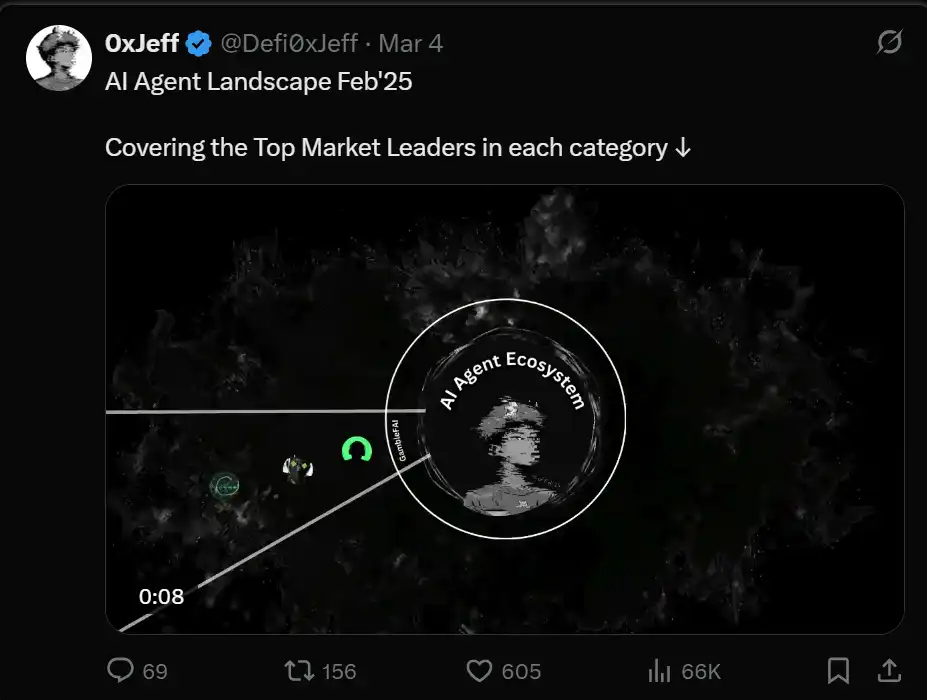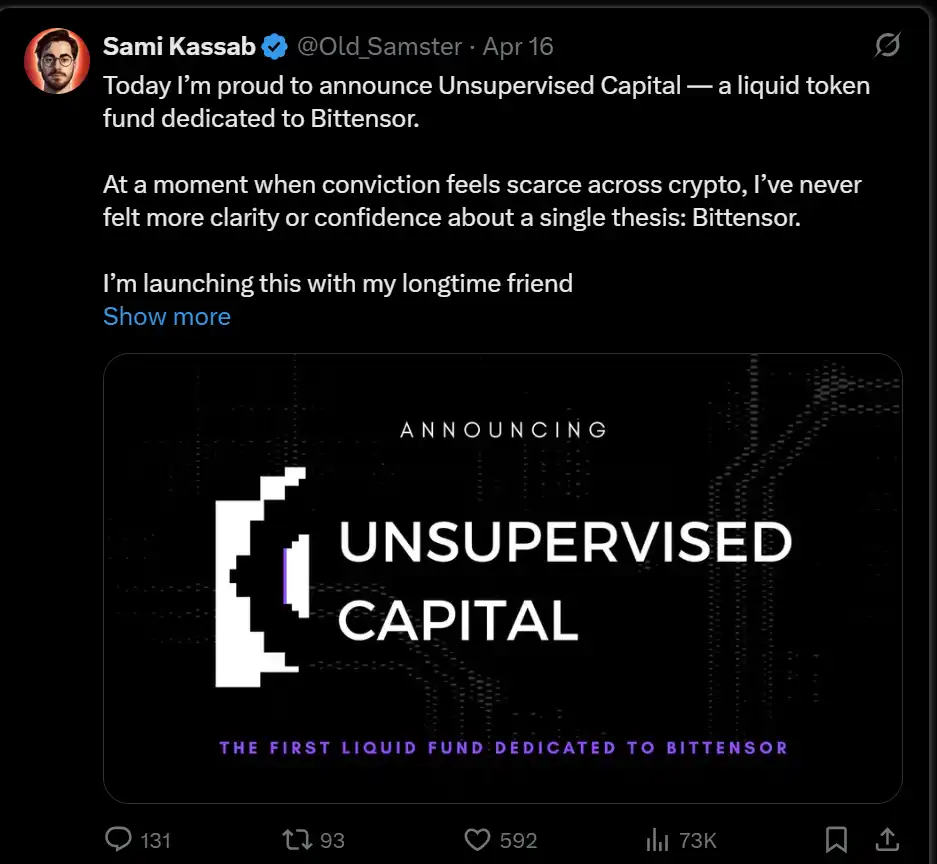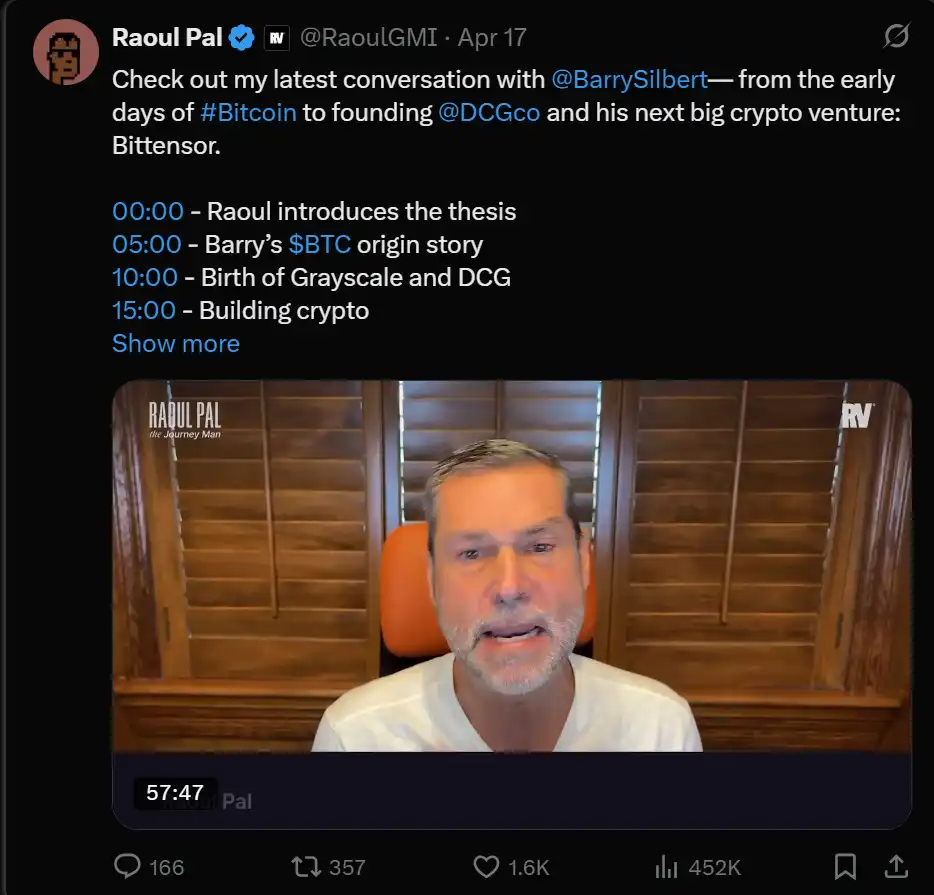Original Title: The Next Crypto AI Meta
Original Authors: @Defi0xJeff, Head of @steak_studio
Original Translation: zhouzhou, BlockBeats
Editor's Note: This article discusses investment opportunities in crypto AI agents and DeAI infrastructure. The liquidity of the AI agent ecosystem is poor and volatile, while the liquidity of the Bittensor ecosystem is better and more stable. DeAI infrastructure is undervalued and has enormous potential, and the combination of agents and infrastructure marketing can bring new workflows and investment opportunities.
The following is the original content (reorganized for better readability):
Since Trump took office, crypto investment has become noticeably more difficult. The overall uncertainty has led funds to flow into "safe-haven assets" rather than risk assets.
The world is closely watching the escalating tariff situation. The crypto market is no exception—while BTC has shown some strength, Fartcoin has performed even more aggressively, almost crushing all other assets.
Others are struggling
Aside from these two assets, other projects (I mean literally all projects) are barely holding on—the Crypto AI sector, which once held a dominant position, has significantly declined, with the overall market cap now around $6 billion. DeFi hasn't fared much better, with on-chain TVL evaporating by over $50 billion, as funds are withdrawing from the crypto market and moving towards other safer assets.
So what should we invest in?
This leads to the key question: how should we invest and what should we invest in during market turbulence?
Most people I know might suggest going to Berachain, Sonic, and other chains for yield farming, which is certainly fine. But for me, there are actually some opportunities with a better risk/reward ratio (R/R) right now, especially worth paying attention to during market volatility.
In my view, the most asymmetric (meaning with huge potential but not fully priced by the market) opportunities lie at the intersection of DeAI infrastructure and AI agents (which I will elaborate on later).
Sticking to the old saying: "Be fearful when others are greedy, and be greedy when others are fearful." (Wait, I think I said that wrong) Yes, "Be fearful when others are greedy, and be greedy when others are fearful." That's right!
The Crypto AI subfields I'm focusing on
In my opinion, there are several subfields in crypto AI that are particularly worth paying attention to right now:
Development tools: including frameworks, Vibe coding tools, MCP infrastructure
Decentralized AI infrastructure: such as decentralized computing power, verifiability, deployment methods, privacy protection, storage, ownership, etc.
Consumer-facing AI: including AI agents, Alpha tools, games, DeFAI, GambleFAI, personalized/companion applications
(This is not an exhaustive list of subfields, but you should get the direction I'm talking about.)
Framework trends
To illustrate the trends in consumer AI/agents and development tools more specifically, I wrote a tweet thread back in March (I originally planned to post monthly, but the market pace hasn't been fast enough to warrant monthly updates).

Frameworks were once highly valued, but that's no longer the case. During the market surge from October to November last year, various AI frameworks' FDV (fully diluted valuation) was driven up significantly. However, when developers realized that these "ready-made frameworks" couldn't actually do much complex work, combined with the fact that large models are vulnerable to prompt injection attacks in financial scenarios (not very secure), the market demand for these frameworks began to cool down.
That said, open-source frameworks and tools like @elizaOS (15.5k GitHub stars), @arcdotfun (3.4k likes), and @sendaifun (1.2k likes) are still growing. In just the past month, they gained 434, 197, and 110 stars, respectively.
Why I think Agent distribution networks are more important than frameworks
Honestly, I'm not that interested in the frameworks themselves—because they don't really have "value accrual." In contrast, investing in Agent distribution networks or Agent Hubs is more interesting because the value loop here is clearer—such as the trading volume generated by speculators or investors trading AI Agent tokens can directly translate into transaction fee revenue.
Currently, @virtuals_io is the best in this regard. Although its daily trading volume has dropped from 8-9 figures to 7 figures, it remains one of the most trusted ecosystems among developers, and it has the most diverse projects and product innovations.
@elizaOS is starting to become interesting. Especially with its Launchpad @autodotfun just launched, it means the team now has a distribution channel that can directly bring value to the $ai16z token. @shawmakesmagic has also teased some interesting new features (not yet launched, but looks promising):

To succeed, they need to nail the launch process for high-quality collaborative projects. If @elizaOS wants to truly differentiate itself from Virtuals, it needs to execute well on the quality of collaborative projects. Otherwise, it could easily fall into a "low-quality projects + four to five-figure market cap" death spiral.
Looking at it from a broader perspective, the most cost-effective direction right now is not Agents or frameworks, but decentralized AI infrastructure (DeAI Infra). Why? If you've been in the AI Agent space for a while, you should be familiar with this evolutionary path: entertainment chat agents ➝ Alpha/tool agents ➝ trading agents ➝ DeFAI abstraction layer ➝ other small narratives ➝ smarter contexts, multi-agent/swarm systems…
The death spiral trap. Many teams fail because the "agent products" they create lack core AI capabilities—the only "intelligence" is just periodically prompting LLMs to say something. Although it's much better than in the early days, most teams still heavily rely on LLMs and ready-made frameworks, and every narrative that comes out results in immature, unrealistic substitutes.
Just like many projects used to fork mainstream DeFi protocols, they would have a six-month hype and then go to zero in a year. The result is: relying on tokens + agents to generate some hype, attract some attention, and then no one uses it, attention drops, tokens drop, falling into a "death spiral."
Agent teams need infrastructure; Infra teams also need Agents. However, these failed teams do have one strength: they know how to do GTM (go-to-market) and generate hype. So the question arises—there are a bunch of Agent teams that can hype and build communities, but they don't have real AI products; what should they do? The answer is: to connect with professional AI models and DeAI infrastructure capabilities (inference networks, training platforms, etc.).
Conversely, DeAI infra teams often struggle with GTM, are not crypto native, and don't understand how to engage with communities. So why not combine the two?
I believe that the connection between "deep AI infrastructure × viral agent distribution" is where the real opportunity lies.
My Crypto AI investment logic:
Invest in DeAI Infra + invest in Agent teams that can rewrite existing Crypto workflows
Web2 has long been using AI agents to automate various vertical workflows, with common cases such as:
Legal field: AI helps law firms read documents, organize case databases, and improve courtroom strategies
Accounting field: AI assists in managing invoices, generating reports, and producing tax documents
Construction field: AI reviews blueprints, estimates budgets, and provides structural optimization suggestions
These types of projects can typically reach 7-8 figure ARR within a few months because they genuinely use AI for automation and enhancement, creating practical value.
In Web3, this idea is still very new. To enhance workflows in DeFi, one must not only understand crypto but also grasp the real pain points of users. Some DeFAI projects attempt to create abstraction layers, but they are basically still at the stage of "needing very precise prompts to be usable," far from being "accessible to ordinary users."
Therefore, I believe that those who truly understand Web3/Crypto workflows are rare. But if you can find these teams and invest in them now, you will reap the greatest rewards when the future explosion occurs.
The problem on the Infra side is—most are not yet investable
DeAI infra teams generally have received VC funding and need a few years before TGE. Some that have already launched tokens have dropped by 50-80%. To stabilize token prices, there is only one way: either they genuinely have revenue, or they find top-tier market makers.
For example, @getgrass_io is a good example: it has a consumer-grade product that exchanges user-contributed bandwidth for airdrops, and it is said to have revenue in the 8-9 figure range. Such projects are few and far between; usually, you can only participate early by using the product or participating in airdrops, and when the token actually launches, high FDV and low circulation make it easy for ordinary people to lose money.
So, what’s more worth paying attention to is—purely community-driven, VC-free DeAI ecosystems. Yes, I’m talking about @opentensor (Bittensor).

However, since the dTAO upgrade launched on Valentine's Day this year, the entire landscape has changed dramatically. Now, the market decides which subnet can receive emissions. The community—meaning the users themselves—has become the allocator of capital. If the community believes your subnet has no product or value, then you won't receive emissions (capital). This compels subnets to build openly and accelerate progress to create products that people truly need.
This shift has even given rise to some hedge funds specifically investing in Bittensor subnets.

@BarrySilbert is betting on the Bittensor ecosystem alongside @YumaGroup (a subsidiary of DCG), which invests in, builds, and incubates Bittensor subnets. Recently, an interview between @RaoulGMI and @BarrySilbert has sparked great excitement in the community (as a major crypto institution has now entered the Bittensor ecosystem).

From an investment perspective, the liquidity of the Bittensor ecosystem is significantly better than that of the AI agent ecosystem. The core issue with agent ecosystems like Virtuals is the liquidity pool (LP) paired with Virtuals, which leads to higher volatility and more impermanent loss (IL) for liquidity providers.
This is why liquidity is often relatively thin—you typically invest $1k to $5k and may experience a slippage of 3% to 7% on these agent tokens. On the other hand, investing a similar amount in subnet tokens results in only about 0.05% to 0.1% slippage (or even lower).
Brief summary:
- The hype cycle for crypto AI agents is waning, and real products and user retention remain scarce.
- DeAI infrastructure is undervalued, misunderstood, and mispriced.
- The best investment opportunities lie in combining infrastructure and agent go-to-market (GTM) strategies to unlock new workflows.
- $VIRTUAL leads the agent space, while Bittensor leads the infrastructure space.
- Keep an eye on teams that combine both—if identified early, there will be significant upside potential.
In conclusion: I believe DeAI will define the next trend in Web3 AI. We will see more teams that change the way we interact with each other and protocols, transform value creation, and generate new submarkets that attract more users and larger market shares (becoming more mainstream). Now is the best time to understand DeAI infrastructure and how it is changing the status quo. Be sure to follow those teams that can successfully combine DeAI and agents.
免责声明:本文章仅代表作者个人观点,不代表本平台的立场和观点。本文章仅供信息分享,不构成对任何人的任何投资建议。用户与作者之间的任何争议,与本平台无关。如网页中刊载的文章或图片涉及侵权,请提供相关的权利证明和身份证明发送邮件到support@aicoin.com,本平台相关工作人员将会进行核查。




